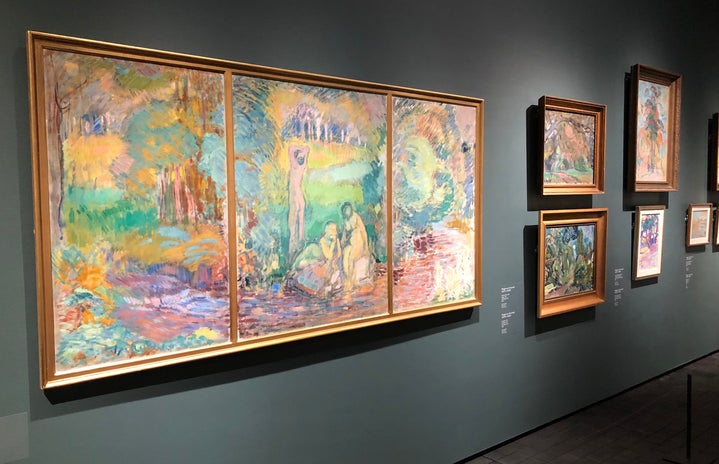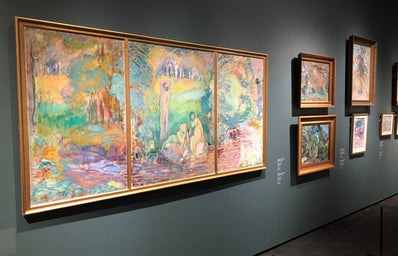With all the articles I’ve written about art, you’d think I was an art major. Truth is, I’m not. Anything I know about art is self-taught through the internet, Youtube, documentaries, and reading those little artwork blurbs at museums; that doesn’t stop me from loving art. Art is subjective, and we often find ourselves drawn to pieces we relate to. This article is on my favourite works of art (and has nothing to do with the talent of any of these artists).
Starry Night Over the Rhone (1888): Vincent Van Gogh
One of my favourite pieces of all time is Van Gogh’s Starry Night Over the Rhone. The Starry Night series Starry Night Over the Rhone has a feeling of tranquility that the more famous Starry Night (1889) lacks. While the stars in Starry Night are painted with harsh strokes in chaotic patterns, with a foreboding dark spire that completely dominates over the small image of the town below, Starry Night Over the Rhone shows calm waters, peaceful lights, and an in-proportion bridge. Van Gogh led a tumultuous life, with his emotions often coming through in his paintings; Starry Night Over the Rhone feels like it was painted during one of his only truly peaceful times. Looking at this painting makes me feel at peace.
Marilyn Diptych (1962): Andy Warhol
This is the first article where I am exposing my obsession with Marilyn Monroe. And while the use of her image is one of my favourite things about this piece, there are a few other reasons this artwork stands out to me. Andy Warhol’s commentary on this piece states that the use of the diptych (a two-paneled wooden canvas painting which is often used in religious art) is a comment on how society views celebrities as deities. He also uses the bright colours on the left to contrast with the black and white fading images on the right to show how Marilyn Monroe faded away. (But let’s be fair, I love this mostly for Marliyn; maybe Warhol was right).
Esther before Ahasuerus (1623): Artemisia Gentileschi
Artemisia Gentileschi was a prominent Renaissance artist who is often left out when telling the history of Renaissance art. Life threw a lot at Gentileschi, but she still managed to become truly successful. Esther before Ahasuerus depicts a story from the Bible, in which Ester comes before the King without an appointment (which was punishable by death in those days) to plead for the massacre of Jewish people to stop. You can feel the drama of the scene through the shadows, colours, and expressions of the subject’s faces. What I love the most about this painting is the way your eyes are drawn to Esther immediately and then allow you to pan out and take in the whole scene.
Infinity Mirrors-The Souls of Millions of Light Years Away (2013): Yayoi Kusama
Yayoi Kusama is a contemporary artist that deals mostly in installation art. While she has made many pieces using the “infinity mirrors” technique, my favourite is The Souls of Millions of Light Years Away which uses hundreds of LED lights in a mirrored room to create the effect of being amongst the stars in space. The room is designed to influence a spiritual experience, where space and time fade into the unconscious. A similar piece, Infinity Mirrored Room—Aftermath of Obliteration of Eternity (2018), uses a dark room, and hundreds of floating lanterns representative of a Japanese funeral ritual. This piece allows you to think about death and the afterlife. It’s a dream of mine to hopefully experience one of these incredible artworks one day in person.
The Creation of Adam (c. 1508-1512): Michelangelo
Part of the impressive Sistine Chapel ceiling fresco, The Creation of Adam is the central piece. While Renaissance art, especially of the biblical nature, is not always my favorite, there is something about this piece that speaks to me. The cleverness Michelangelo uses in this piece draws me in. Looking closely, you can see the figure of God surrounded by a brain-shaped shell, about to infuse Adam with the gift of consciousness. In the space between the hand of God and his creation Adam, there is magic.
Defacement (The Death of Michael Stewart) (1983): Jean-Michel Basquiat
Jean-Michele Basquiat started off as a street artist, using his artwork as a form of social commentary. While all his pieces are chaotic and colourful, many contain a hidden (or not-so hidden) message. Defacement was painted as a response to the police brutality and racism that Black people were facing (and still face) every day. The reason I love this piece so much is that it is so simple but so powerful. A thousand words on police brutality and racism are replaced by the eloquence, powerfulness, and emotion portrayed in this image painted by Basquait.
The Great Wave (1820s): Katsushika Hokusai
The Great Wave is a print on a wooden block and is part of Hokusai’s series 36 Views of Mount Fuji. Mount Fuji is a gigantic mountain but using the perspective of a giant wave in the sea, Hokusai was able to make it look tiny. What attracts me to this image is the power of the wave and the use of water to turn a powerful mountain into a small, almost insignificant figure off in the distance. It reminds me of the uncontrollable strength I feel when I’m around water (which is weird because I’m a fire sign), and brings with it a sense of acceptance, knowing that there are some primordial forces I can’t control.
The American People Series (1960s): Faith Ringgold
Faith Ringgold is a new artist I discovered while I was in the process of fact-checking for this article. Even though I haven’t known her long, the art that Ringgold creates is unlike anything I’ve ever seen. Her images of figures are poignant and haunting, and she uses her work as a message. The American People Series is a collection of images depicting Ringgold’s surroundings in 1960s America. A quote from Ringgold on this work says, “I became fascinated with the ability of art to document the time, place, and cultural identity of the artist. How could I, as an African American woman artist, document what was happening around me?” (source). The final piece in this series is entitled Die, representing the riots that were happening in 1967, and showcasing that no one was safe from the violence.
Ignorance = Fear (1989): Keith Haring
I recently became absolutely obsessed with Keith Haring’s artwork. His simple dancing figures, his quick, full-of-life drawings, all draw me in and speak to a way that most other art hasn’t. Ignorance = Fear is a piece of political activism, commenting on the poor treatment of the AIDS crisis, referencing how government officials were trying to sweep it under the rug. This piece represents the age-old phrase “hear no evil, speak no evil, see no evil” but twisting it to fit the situation of the AIDS crisis, with “Fear = Ignorance” and “Silence = Death” written along the borders to call out those who refused to treat AIDS patients. This piece is not uncommon for Haring, who used his work to comment on other societal problems like the crack epidemic of the 70s and 80s. Far from being the first artist to do this, Haring also believed in open access to art and opened a shop in order for his art to be reached by the masses.
Roots (1979): Daphne Odjig
Another artist I recently began following is Daphne Odjig, an Anishinaabe artist who used her art as a means of activism and to tell the stories of Indigenous peoples. Daphne Odjig was directly responsible for opening the first all-Indigenous artwork gallery and helped to found the Professional Native Indian Artists Inc, which eventually became known colloquially as “the Indian Group of Seven.” While all her work is stunning, the one that caught my eye was Roots, which uses bright colours and clean lines to give the painting an almost stained glass window effect. Daphne Odjin was not only a brilliant artist, but an inspiration and mentor to many other Indigenous artists who were struggling to come into their own in a world full of racism and unfair distribution of opportunity.
Red Canna (1924): Georgia O’Keeffe
Georgia O’Keeffe was one of the most successful artists during the Abstract/Modernist movement, producing works full of colour and movement. Red Canna is perhaps one of her most famous paintings, with the red and orange flower patterns instantly recognizable. The motif of vitality and reproduction is very prevalent in O’Keeffe’s works, which can be viewed in this painting. The way O’Keeffe is able to use movement and line in such a simple image is why it is so captivating and interesting to look at.
Love is in the Bin (2018) (originally Girl with Balloon, 2006): Banksy
Finally, no modern artist’s name is as familiar to the Western world as Banksy’s. With their powerful social commentary, shocking exhibits, and the added elusiveness of their identity, Bansky is the complete performance art package. While Banksy has made some incredible pieces with very important messages calling for social change, my favourite is their Love is in the Bin piece. You may notice there are two names in the title, and in case you aren’t familiar with the story, Banksy’s piece Girl with Balloon was up for auction at a very prestigious gallery (that didn’t even want to include the piece in the first place). Upon the piece selling for $1, 042, 000 it was promptly dropped through the base of the frame which disguised a paper shredder. The art world was shocked at this display, and I have to say, it was absolutely thrilling to see.
As you can see, my favourite pieces come from a variety of styles, artists, and movements. To me, people being able to see and participate in art is one of the most important things in the world. Art brings community, it allows expression, and it tells a story. Without it we would be absolutely lost.


